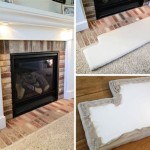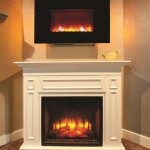Antique Ceramic Fireplace Insert: A Timeless Fusion of Art and Function
Antique ceramic fireplace inserts represent a significant element in the history of interior design and heating technology. These inserts, often crafted with intricate details and vibrant glazes, served a dual purpose: providing warmth and acting as a decorative focal point within a home. Examining their historical context, manufacturing techniques, design characteristics, and restoration considerations provides a comprehensive understanding of their enduring appeal and value.
The usage of ceramic materials in fireplace construction dates back centuries, with early examples found in ancient civilizations. However, the refinement of ceramic fireplace inserts as we recognize them today largely occurred during the Victorian and Edwardian eras. These periods witnessed a surge in industrial production and advancements in ceramic technology, making decorative inserts more accessible to a broader segment of the population. The availability of coal as a relatively affordable fuel source also fueled the demand for efficient and aesthetically pleasing fireplaces.
These inserts were not merely functional; they were statements of taste and affluence. The intricate designs and colorful glazes reflected the artistic sensibilities of the time, often incorporating motifs inspired by nature, mythology, and classical architecture. Owning a well-crafted ceramic fireplace insert signaled social standing and a commitment to refined living.
Historical Significance and Evolution
The development of the ceramic fireplace insert is intertwined with the technological advancements in both heating and ceramic production. Early fireplaces were primarily open hearths, inefficient in terms of heat retention and prone to generating smoke within the living space. The introduction of fireplace inserts, particularly those made of cast iron and later enhanced with ceramic facings, addressed these issues. The ceramic components served to radiate heat more effectively and provided a barrier to prevent direct contact with the hot metal surface. Over time, the design of these inserts evolved from simple, utilitarian forms to elaborate, ornamental pieces that were integral to the overall décor of a room.
The Victorian era (1837-1901) marked a high point in the popularity of ceramic fireplace inserts. During this period, mass production techniques made inserts more affordable, and a wide variety of styles became available. Manufacturers offered inserts in numerous colors and patterns, catering to diverse tastes and budgets. The Aesthetic Movement, with its emphasis on beauty and artistry in everyday objects, further fueled the demand for decorative fireplace inserts.
The Edwardian era (1901-1910) saw a continuation of the trends established during the Victorian period, albeit with a subtle shift towards simpler, more streamlined designs. While ornamentation remained important, there was a growing emphasis on functionality and efficiency. The Art Nouveau and Art Deco movements also influenced the design of fireplace inserts, leading to the incorporation of organic forms, geometric patterns, and stylized motifs.
The decline in the popularity of coal-burning fireplaces in the mid-20th century led to a decrease in the production and use of ceramic fireplace inserts. However, in recent years, there has been a resurgence of interest in these historical artifacts, driven by a growing appreciation for their beauty, craftsmanship, and historical significance.
Manufacturing Techniques and Materials
The production of antique ceramic fireplace inserts involved a combination of skilled craftsmanship and industrial processes. The underlying structure of the insert was typically made of cast iron, chosen for its durability and ability to withstand high temperatures. The ceramic components, which formed the visible front of the insert, were created using a variety of techniques, including molding, slip casting, and hand-painting.
The ceramic materials used in fireplace inserts typically consisted of earthenware or porcelain, depending on the desired level of durability and aesthetic qualities. Earthenware, a porous clay body fired at relatively low temperatures, was often used for less expensive inserts. Porcelain, a denser and more translucent ceramic material fired at higher temperatures, was reserved for higher-quality inserts.
The glazing process was crucial in imparting color, texture, and durability to the ceramic components. A variety of glazes were used, ranging from simple monochromatic finishes to complex polychrome designs. The glazes were applied either by hand or using mechanized methods, and then fired in kilns at high temperatures to fuse them to the ceramic surface. The firing process was critical in determining the final color and appearance of the glaze, and skilled kiln operators were essential to ensure consistent results.
The process of creating intricate designs on ceramic inserts often involved the use of stencils, transfers, and hand-painting techniques. Stencils were used to apply repetitive patterns, while transfers allowed for the reproduction of complex images and scenes. Hand-painting was employed to add fine details and individualize each insert. Skilled artisans meticulously applied the glazes using brushes and other tools, creating unique works of art that enhanced the aesthetic appeal of the fireplace.
Design Characteristics and Styles
Antique ceramic fireplace inserts exhibit a wide range of design characteristics and styles, reflecting the diverse artistic influences and cultural trends of the periods in which they were created. Some common design elements include floral motifs, geometric patterns, classical ornamentation, and figural representations. The style of the insert often corresponded to the architectural style of the house in which it was installed, creating a sense of harmony and coherence.
Victorian-era inserts often featured elaborate ornamentation, including intricate floral patterns, scrolling foliage, and depictions of birds, animals, and mythical creatures. The colors used in these inserts were typically rich and vibrant, reflecting the Victorian penchant for bold and opulent décor. Common colors included ruby red, emerald green, sapphire blue, and gold. The Aesthetic Movement influenced the use of Japanese-inspired motifs, such as cherry blossoms, bamboo, and cranes.
Edwardian-era inserts tended to be simpler and more restrained in their design. While ornamentation was still present, it was often less elaborate and more stylized. Geometric patterns, such as squares, rectangles, and circles, became more common, reflecting the influence of the Art Deco movement. The colors used in these inserts were often softer and more muted, with a greater emphasis on pastel shades and earth tones.
Art Nouveau inserts, which were popular during the late Victorian and Edwardian periods, featured flowing, organic lines and stylized representations of flowers, leaves, and other natural forms. These inserts often incorporated curvilinear shapes and asymmetrical designs, creating a sense of movement and dynamism. The colors used in Art Nouveau inserts were typically soft and iridescent, with a focus on greens, blues, and purples.
The size and shape of ceramic fireplace inserts also varied depending on the size and style of the fireplace. Some inserts were designed to fit flush with the surrounding wall, while others projected outwards, creating a more three-dimensional effect. The shape of the insert could be rectangular, arched, or even oval, depending on the design preferences of the homeowner.
Restoration and Preservation Considerations
Antique ceramic fireplace inserts are delicate objects that require careful handling and preservation. Over time, they can become damaged due to exposure to heat, moisture, and physical impact. Cracks, chips, and glaze loss are common problems that can detract from the aesthetic appeal and structural integrity of the insert. Restoring and preserving these historical artifacts requires specialized knowledge and skills.
Before undertaking any restoration work, it is important to assess the condition of the insert and determine the extent of the damage. A qualified conservator can provide an expert evaluation and recommend appropriate treatment options. In some cases, minor repairs, such as filling small chips or cracks, can be carried out by the homeowner. However, more extensive damage should be addressed by a professional.
Cleaning antique ceramic fireplace inserts should be done with care, using mild detergents and soft cloths. Abrasive cleaners and harsh chemicals should be avoided, as they can damage the glaze and underlying ceramic body. It is also important to avoid soaking the ceramic in water, as this can cause further damage.
When repairing cracks or chips in ceramic fireplace inserts, it is important to use materials that are compatible with the original ceramic body and glaze. Epoxy resins and other adhesives can be used to bond broken pieces together, but it is important to choose products that are specifically designed for ceramic repair. The repaired areas should be carefully filled and smoothed to blend seamlessly with the surrounding surface.
Replacing missing or damaged sections of ceramic fireplace inserts can be a challenging task. In some cases, it may be possible to find replacement pieces from salvage yards or antique dealers. However, if replacement pieces are not available, it may be necessary to have them custom-made by a ceramic artist. Creating replicas of antique ceramic components requires a high level of skill and expertise, as the new pieces must match the original in terms of color, texture, and design.
Protecting antique ceramic fireplace inserts from further damage is essential for preserving their longevity. This can be achieved by limiting their exposure to heat, moisture, and physical impact. When using the fireplace, it is important to avoid overheating the insert, as this can cause the ceramic to crack or warp. The fireplace should also be properly ventilated to prevent the build-up of moisture and condensation. Finally, the insert should be protected from accidental impacts and scratches by using protective covers or barriers.

Antique Humphrey Radiantfire Gas Insert Early 1900s Faux Fireplace Remodel

For Details Cast Iron Fireplace Insert Gas

Oxford Cast Iron Fireplace Insert Edwardian Fireplaces

Ceramic Fireplaces 74 For On 1stdibs Fireplace Insert Antique Gas

Belmont Small Gas Insert

Antique Vintage Ray Glo Gas Heater Ceramic Bricks Adapt Fireplace Grate Insert

A Decorative Cast Iron Fireplace Insert With Delft Tiles Antique Fireplaces And Surrounds Thornhill Galleries

19th Century Victorian Cast Iron Tiled Fireplace Insert Tile Inserts Antique Mantels

19th Century Victorian Cast Iron Fireplace Tiled Insert At 1stdibs Antique Coal Tiles

Nordik 34i Kozy Heat Fireplaces








